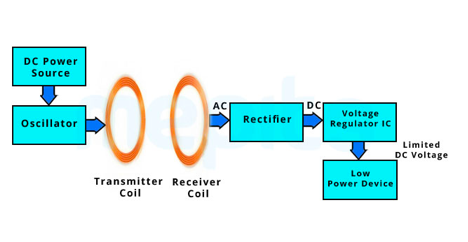Wireless Power transmission is the Future
If you have ever considered using a laptop or smartphone without plugging it into an electrical outlet? How about viewing TV without hooking up the power cord?
So, it's not impossible. The principle of wireless electricity makes this possible. Power can be transferred from one piece of electronic equipment to another via wireless electricity [1], with air as the medium of transmission as shown in figure 1. Nikola Tesla was the first person to attempt to transmit power wirelessly [2].
Figure 1: Architecture of Implementation of wireless electricity at home
Huge advances in technology and social progress can be attributed to Nikola Tesla. He developed an alternating current, which simplified the generation and transmission of electricity [3]. He developed the laser, which is now employed in various fields, including science, defense, medicine, industry, and business. In addition to the electric motor, the radio, the x-ray, and the remote control, he invented a plethora of other technologies [4]. He also developed methods for collecting and redistributing light.
To prove his theory of wireless power transfer, Nikola Tesla performed the earliest known demonstrations of it in 1899. Without the use of wires, he managed to supply energy to a field of fluorescent lights that was more than twenty-five kilometers away [5]. A transmitter and receiver coil are needed for this technology to work. The transmitter coil creates a magnetic field when an alternating current flows through it [6]. This causes the receiver coil to produce a voltage. Use it to charge a battery or run a mobile device. To elaborate, a circular magnetic field is produced around a wire whenever we induce an electric current via it. And if we wind the wire into a coil, the magnetism increases. Now, if we install a second, unpowered coil of wire inside the first coil's magnetic field, current will begin to flow in the second coil as a result of inductive coupling as shown in figure 2.
Figure 2: Circuit Architecture of Wireless Power Transmission
In the realm of technology, wireless electricity is cutting-edge and developing quickly. The word "WiTricity" has also been used in recent years to describe it [7]. WiTricity Corporation, founded in 2007, is leading the charge to bring wireless electricity to the masses by creating a new industry. Soon, wireless electricity will cause a dramatic shift in the scientific world.
Reference
[1] Manish Bhardwaj, Selection of Efficient Relay for Energy-Efficient Cooperative Ad Hoc Networks, American Journal of Networks and Communications. Special Issue: Ad Hoc Networks. Volume 4, Issue 3-1, May 2015, pp. 5-11. doi: 10.11648/j.ajnc.s.2015040301.12
[2] Manish Bhardwaj, Enhance Life Time of Mobile Ad-hoc Network Using WiTriCity and Backpressure Technique, Procedia Computer Science, Volume 57, 2015, Pages 1342-1350, ISSN 1877-0509, https://doi.org/10.1016/j.procs.2015.07.447.
[3] Kanwal Deep Kaur, Manish Bhardwaj, Effective Energy Constraint Routing with On-Demand Routing Protocols in MANET, American Journal of Networks and Communications. Volume 4, Issue 2, April 2015, pp. 21-24. doi: 10.11648/j.ajnc.20150402.12
[4] Shivani Rohilla, Megha Sharma, A. Kulothungan, Manish Bhardwaj, Privacy Preserving Data Publishing through Slicing, American Journal of Networks and Communications. Special Issue: Ad Hoc Networks. Volume 4, Issue 3-1, May 2015, pp. 45-53. doi: 10.11648/j.ajnc.s.2015040301.18
[5] Prasad Mahapatra, Rajendra; * | Bhardwaj, Manish | Pandey, Sachi, Performance analysis of mobile ad hoc routing protocols using extensive metrics, International Journal of Knowledge-based and Intelligent Engineering Systems, vol. 16, no. 3, pp. 177-183, 2012.
[6] Megha Sharma, Shivani Rohilla, Manish Bhardwaj, Efficient Routing with Reduced Routing Overhead and Retransmission of Manet, American Journal of Networks and Communications. Special Issue: Ad Hoc Networks. Volume 4, Issue 3-1, May 2015, pp. 22-26. doi: 10.11648/j.ajnc.s.2015040301.15
[7] Bhardwaj, M. and Ahlawat, A. (2018) Wireless Power Transmission with Short and Long Range Using Inductive Coil. Wireless Engineering and Technology, 9, 1-9. doi: 10.4236/wet.2018.91001.
Ananya Anand
Department of Computer science and Engineering,
KIET Group of Institutions,
Delhi-NCR, India



Comments
Post a Comment